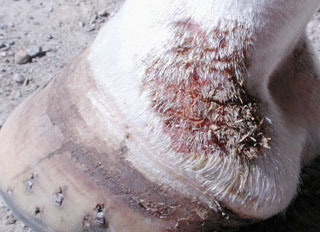GREASY HEEL COMPLEX
Greasy heel has been a long term headache for a lot of horse owners. This is a common skin condition of the heels and pasterns. At first reddening and swelling may occur developing into painful scabs, crusts, oozing and skin cracks. The condition is quite often refractory to treatment, or can seem to settle down only to flare up again. One reason for this is that there are a number of different forms of the disease, and while one type of treatment may work for one type of the disease it won’t for the others.
Essentially there are at least four forms of the disease which have similar appearance:
- Pastern dermatitis. This is the classic form of the disease where contact with mud, wetting, unhygienic surroundings or abrasive surfaces allows the skin to be damaged allowing infection of the skin to take place. It is common in working pacers, gallopers and endurance horses.
- Pastern folliculitis. A bacterial pyoderma with painful infected oozing thickened skin.
- Dermatophilus infection. The rainscald germ causing the characteristic matted hairbrush lesions of the pasterns – more common in younger horses.
Treatment of the above conditions involves various modalities involving: cleaning of affected areas with antiseptic or astringent solutions, emollient creams, and antibiotics.
- White sock photosensitive type. This was once more technically called “photoactivated vasculitis”, but is now more correctly known as, the mouthful, “pastern leukocytoclastic vasculitis” (PLV). As can be gathered from these terms sunlight plays a part in this disease process. This is by far the most common and problematic of the greasy heel cases we treat at our clinic. The disease has the following common factors:
(a) Affects unpigmented (white sock) skin areas
(b) Skin appears to be sensitized by either infection or some kind of damage
(c) UV light plays a role in initiating and perpetuating the disease.
(d) Thus we see this problem more commonly in the spring and summer months corresponding with the highest levels of UV light in the state.
(e) Draft and paint horses can be particularly sensitive to the disease.
This form of the disease is still not properly understood, but there appears to be an underlying complex immune component which is central to the production of the disease. Research on affected skin specimens show a degeneration of the surface blood vessels (vasculitis) with a collection of specific white cells surrounding them (leukocytoclastic), hence the “PLV” term. Clinically the disease looks similar to sunburn but long after the initial insult the hyperimmune reaction continues. This is why the majority of treatments fail after the initial infection has gone.
While we are still not the full bottle on this condition from these studies we can make recommendations and treatments:
- Earlier the treatment the better. In our experience the longer the disease has been present (especially if the horse has been too aggressively treated) the harder it is to clear up the disease.
- Cleanliness is extremely important. Affected areas should be kept clean and removal of scabs should be by using emollient creams, bandages or soaking in just warm water, not making them bleed.
- Prevent further exposure of affected areas to UV radiation either by :-
(a) Bandaging and leg wraps are particularly effective. There are paddock boots specifically designed for horses affected by PLV, and can be used as a preventative measure on horses that are affected on a seasonal basis.
or
(b) Box during daylight hours. One patient of ours which was a long term sufferer of this disease was only finally cured when the horse was boxed during the day.
4. Parental corticosteroids by acting on the immune component are particularly effective in management of this disease.
Persistence is of the essence with this form of the disease and treatment needs to be continued until the symptoms are well and truly gone.

